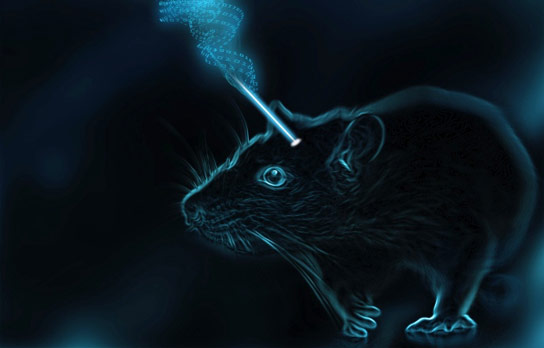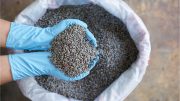
By controlling rats’ brain cells they had genetically engineered to respond to light, researchers were able to create fearful memories of events that never happened — and then to erase those memories again. Credit: Sadegh Nabavi and Sina Alizadeh
In a newly published study, scientists at the University of California show the ability to selectively remove a memory and predictably reactivate it by stimulating nerves in the brain at frequencies that are known to weaken and strengthen the connections between nerve cells.
Researchers at the University of California, San Diego School of Medicine have erased and reactivated memories in rats, profoundly altering the animals’ reactions to past events.
The study, published in the June 1 advanced online issue of the journal Nature, is the first to show the ability to selectively remove a memory and predictably reactivate it by stimulating nerves in the brain at frequencies that are known to weaken and strengthen the connections between nerve cells, called synapses.
“We can form a memory, erase that memory and we can reactivate it, at will, by applying a stimulus that selectively strengthens or weakens synaptic connections,” said Roberto Malinow, MD, PhD, professor of neurosciences and senior author of the study.
Scientists optically stimulated a group of nerves in a rat’s brain that had been genetically modified to make them sensitive to light, and simultaneously delivered an electrical shock to the animal’s foot. The rats soon learned to associate the optical nerve stimulation with pain and displayed fear behaviors when these nerves were stimulated.
Analyses showed chemical changes within the optically stimulated nerve synapses, indicative of synaptic strengthening.
In the next stage of the experiment, the research team demonstrated the ability to weaken this circuitry by stimulating the same nerves with a memory-erasing, low-frequency train of optical pulses. These rats subsequently no longer responded to the original nerve stimulation with fear, suggesting the pain-association memory had been erased.
In what may be the study’s most startling discovery, scientists found they could re-activate the lost memory by re-stimulating the same nerves with a memory-forming, high-frequency train of optical pulses. These re-conditioned rats once again responded to the original stimulation with fear, even though they had not had their feet re-shocked.
“We can cause an animal to have fear and then not have fear and then to have fear again by stimulating the nerves at frequencies that strengthen or weaken the synapses,” said Sadegh Nabavi, a postdoctoral researcher in the Malinow lab and the study’s lead author.
In terms of potential clinical applications, Malinow, who holds the Shiley Endowed Chair in Alzheimer’s Disease Research in Honor of Dr. Leon Thal, noted that the beta-amyloid peptide that accumulates in the brains of people with Alzheimer’s disease weakens synaptic connections in much the same way that low-frequency stimulation erased memories in the rats. “Since our work shows we can reverse the processes that weaken synapses, we could potentially counteract some of the beta amyloid’s effects in Alzheimer’s patients,” he said.
Co-authors include Rocky Fox and Christophe Proulx, UCSD Department of Neurosciences; and John Lin and Roger Tsien, UCSD Department of Pharmacology.
This research was funded, in part, by the National Institutes of Health (grants MH049159 and NS27177) and Cure Alzheimer’s Fund.
Reference: “Engineering a memory with LTD and LTP” by Sadegh Nabavi, Rocky Fox, Christophe D. Proulx, John Y. Lin, Roger Y. Tsien and Roberto Malinow, 1 June 2014, Nature.
DOI: 10.1038/nature13294









Be the first to comment on "Scientists Confirm Cellular Basis for Memory by Implanting and Erasing Fear in Rats"